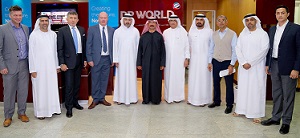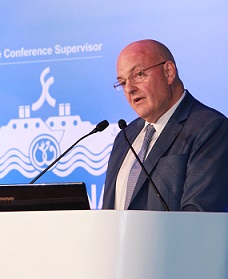His Excellency Sultan Ahmed Bin Sulayem, DP World Group Chairman and Chief Executive Officer; Zeyad Baker, Executive Director, Dutco Balfour Beatty LLC and Patrick McKinney, Area Manager, Middle East and Gulf, BAM International Abu Dhabi LLC – Dubai Branch, signed on behalf of their respective companies.
The ceremony took place at DP World Head Office in Jebel Ali and was attended by senior officials including Vice Chairman HE Jamal Majid Bin Thaniah, Senior VP and MD of UAE Region Mohammed Al Muallem, Senior VP Global Procurement Iqbal Khoory and Senior VP Project Management Adnan Al Abbar.
Under Phase 1, Dutco Balfour Beatty LLC is developing an operational yard area with a quay length of 1,200m. BAM International Abu Dhabi LLC is building a 400m bridge and adjacent causeways and the 2.2 km quay wall with an alongside depth of 18 metres, designed to accommodate the largest mega container vessels. CH2M HILL (Halcrow) will deliver the civil works on the reclaimed island north of Jebel Ali’s Terminal 2, connected to the mainland by a 3,000 metre causeway.
HE Sultan Ahmed Bin Sulayem, DP World Group Chairman and Chief Executive Officer, said: “We are excited to see construction work going ahead as planned for Container Terminal 4 in the run up to Expo 2020. We continue to support the transformation of Dubai into the world’s smartest city as envisioned by His Highness Sheikh Mohammed Bin Rashid Al Maktoum, Vice President and Prime Minister of the UAE and Ruler of Dubai.
“This terminal is the big idea that will change the way ports work in the future. We will deploy the latest technology in equipping our quays and yards, and run them with the most sophisticated terminal operation systems. We have a long track record of investing proactively to expand capacity at our operations to meet changing customer needs. We are building Terminal 4 from the ground up, which enables us to future proof it for smart container ships emerging in the future.”
Under Phase 1, Terminal 4 will add 3.1 million TEU (twenty-foot equivalent units) by 2018, taking Jebel Ali Port’s total capacity to 22.1 million TEU. The port will be equipped with at least 110 cranes with a total quay length of around 11,000 metres by that time.
DP World will further expand Terminal 4’s capacity to a total of 7.8 million TEU in line with market demand under Phase 2, with an additional operational yard with a quay length of 1,000 metres that will be built by Dutco Balfour Beatty LLC.
Zeyad Baker, Executive Director, Dutco Balfour Beatty LLC, said: “Dutco Balfour Beatty is honoured to be selected for this project. Our association with DP World goes back to 1976 when we undertook the construction of Jebel Ali Port. Our new partnership for this exciting new chapter in the port’s development demonstrates the long term nature of our continuous involvement in a port that emerged four decades ago to become the world’s largest man-made harbour. We thank DP World for the sustained trust they have placed in us.”
Patrick McKinney, Area manager, Middle East and Gulf, BAM International Abu Dhabi LLC – Dubai Branch, said: “We are delighted to be associated with a global trade enabler like DP World in developing infrastructure. We are grateful for their confidence in our expertise and capabilities to execute this engineering challenge. Our strategy of deploying advanced construction techniques, expert line management highlighting safety processes will underpin the delivery of this project on time and on budget.”
Terminal 4 will be equipped with semi-automated quay cranes, providing operational efficiencies for customers, comfortable and safe working conditions for employees and environmental benefits by reducing its carbon footprint.
Phase 1 will feature 13 of the world’s largest and most modern quay cranes, remotely operated from a sophisticated control room off the quayside. Some 35 Automated Rail Mounted
Gantry cranes (ARMG) will operate in the yard.
Mr Bin Sulayem, added: “With our 4 million capacity TEU Container Terminal 3 fully operational this year, Jebel Ali will have the capability to accommodate ten mega container ships simultaneously and the new Terminal 4 will increase that handling capability. It will be ready in time to meet the expected increase in trade over the next five years and to ensure Jebel Ali Port reinforces its position as the top commercial gateway to this region.”
When completeTerminal 4 will operate as a dedicated container operation, including storage of full, reefer and empty containers using modern container handling equipment.
Jebel Ali and other DP World terminals in the UAE handled 15.6 million TEU in 2015. Utilisation at Jebel Ali remains high at approximately 90%. Last year, DP World ‘s global
portfolio of container terminals handled 61.7 million TEU.




